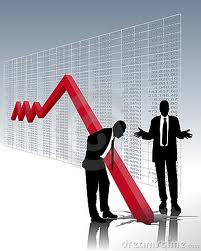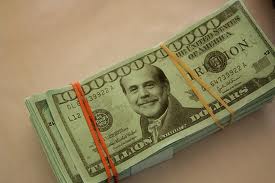The Trillion Dollar Mistake That Triggered the Economic Meltdown

It was summer, 2006, and Fed Chair Alan Greenspan had just raised interest rates for the 17th consecutive time in an effort to cool off the over-heated U.S. housing market.
And it was working.
By the third quarter of 2006, defaulting loans became the first foreclosures of today’s full blown crisis, and as 2007 began, defaults were occurring at the fastest rate in a decade. Finally, as the summer of 2007 was approaching, even though the prices of some bonds backed by sub-prime loans had dropped, their ratings reflected no change.

London… July 10, 2007
It was July 2007… the 10th to be specific, and Moody’s and Standard & Poors (“S&P”) were each slated to hold press conferences that day.
S&P made its announcement before the opening of U.S. markets. Citing a declines in U.S. housing, it announced that it would be cutting the ratings on $12 billion worth of the $565 billion in securities backed by sub-prime bonds issued late 2005 and into 2006.
After the markets closed that day, Moody’s lowered credit ratings on 399 bonds backed by subprime mortgages that had been issued in 2006, totaling $5.2 billion.
S&P and Moody’s were characterizing their actions as being, “the biggest ever in the sub-prime market.” Investors were very critical, however, asking why and why now… and why nothing had been done sooner.
It might have ended there, but I suppose that S&P felt compelled to address the criticism related to the timing of the downgrades. According to Bloomberg, S&P managing director, Tom Warrack, explained that performance issues don’t show up right away, and require time to assess.
“We have been surveilling these deals actively on a regular basis beginning in 2005 and 2006. We believe that the performance that we’ve been able to observe now warrants action.”
S&P also mentioned that it would be changing certain practices going forward including a change in methodology for rating both new and existing mortgage-backed securities to incorporate the increasing probability that mortgage defaults will lead to losses for bond investors. Also that it was reviewing the “global universe” of CDOs containing sub-prime mortgages.
(Collateralized debt obligations, by the way, were created back in 1987 by the friends of Charles Keating and Michael Milken, the bankers at long since defunct Drexel Burnham Lambert Inc. Later, these same guys created today’s credit default swap. If next time the crisis we have actually leave us all living in cardboard huts eating dirt pie, what would you like to bet me it’s these guys that invented whatever finally took us down for good. I’m just saying…)
And data S&P used was also called into question that day by the ratings agency…
“Data quality is fundamental to our rating analysis,” S&P said. “The loan performance associated with the data to date has been anomalous in a way that calls into question the accuracy of some of the initial data provided to us.”
In terms of wrapping things up, it’s hard to imagine how S&P might have spooked investors more. It was like they stopped just short of yelling, “FIRE!” in a crowded theater… but it was enough and investors were already headed towards the exit doors.
“We do not foresee the poor performance abating. Loss rates, which are being fueled by shifting patterns in loss behavior and further evidence of lower underwriting standards and misrepresentations in the mortgage market, remain in excess of historical precedents and our initial assumptions.”
Poor performance in excess of historical precedents not abating? Uh oh.
The Outcome… 24 hours later
That fateful day Moody’s cut the ratings of 214 bonds from investment grade… to junk.

Almost overnight, insurers and pension plans had no choice but to dump downgraded bonds, ultimately driving down prices on $800 billion in subprime mortgages and $1 trillion of collateralized debt obligations (“CDOs”). Institutional Risk Analytics said that CDO investors alone could “lose as much as $250 billion.”
Lehman Bros. shares fell by 5 percent… Bear Stearns by 4.1 percent. Lehman was the number one underwriter of Mortgage-backed Securities and Bear, number two.
Paul Colonna, a bond manager for GE Asset Management realized…
“There are thousands of deals in this space, and the manpower it takes to review each one means they can’t stay on top of things.”
The decisions made by investors following July 10, 2007 are easy to understand. With S&P and Moody’s downgrading certain bonds, what was going to happen to the other 99 percent of bonds backed by sub-prime loans? Why would they be any better? And what about the bonds backed by Alt-A loans, were they really much different in terms of credit quality?
Investors simply decided that they were not going to stick around to find out.

A Butterfly Effect…
The bonds being reviewed by S&P and Moody’s had loans originated by New Century, Fremont General, Washington Mutual, and Long Beach Savings, all of which ended badly. All of Long Beach Savings’ 75 MBSs, which started out rated as investment grade securities, ended as junk.
But in July of 2007, it was still a relatively small problem from the perspective of the Chairman Bernanke and the Fed… it was something happening in the sub-prime sector, and that’s where many thought it would stay. Again, according to Bloomberg…
Delinquencies and foreclosures are increasing for bonds issued in 2006, S&P said. Total losses on all subprime transactions issued since the fourth quarter of 2005 are 0.29 percentage point, compared with .07 percentage point for similar transactions from 2000, which until now had been the worst performing this decade.
As the late days of summer 2007 went by, it was becoming more apparent that although the impact of what had happened in the sub-prime bond market was still small in dollar terms… as of August 15, 2007 investor losses were only $35 billion, which is equivalent to the stock market dropping by .2 percent… there was the very definite potential for that impact to seep into other areas.
The problem is that when people realize that they’ve underestimated risk in one part of the financial markets, they get nervous about other decisions they’ve made. Investor insecurity takes hold, and people start questioning whether they’ve accurately evaluated their exposure to risk in other areas.

The Credit Freeze…
Within a few weeks of the S&P and Moody’s press conferences… by July 30, 2007, what had started with the downgrading of a small number of bonds backed by sub-prime loans was having a chilling effect on various financial markets.
On August 9, 2007, the Federal Reserve’s Open Market Trading Desk injected $24 billion into the U.S. banking system using repurchase agreements… or “repos” for short. The very next day the Fed injected an additional $38 billion into the financial system. And about a week after that, the Fed did it again, this time executing repos for just $2 billion. The European Central Bank had already injected $130 billion into its financial institutions, and there would be more to follow… a lot more.
A repurchase agreement is a short-term loan in which a security is exchanged as collateral for the cash, with the agreement that the transaction will be reversed on a specific date at an agreed to price… in some cases the transaction gets reversed as soon as the next day, others are for periods of 14 days.
It could be thought of as an overnight mortgage.
You pledge your home to a bank in exchange for a loan, and a financial institution pledges a bond to the Federal Reserve in exchange for the use of funds either overnight or for as long as 14 days. When the Fed engages in repo transactions with banks it is not “bailing out banks,” it’s loaning money that it will get back the next day or next week.
On the other hand, if the Fed were to take $24 billion in cash and hand it out to people who need it, that would increase the quantity of money in circulation… and that, ultimately, is inflationary. But pumping liquidity into the financial markets during a crisis is loaning money to the system in such a way as to not increase the money supply.

Why did the Fed do what it did on August 9, 2007?
Part 1 ““ First Frozen Fidelity Federal Bank
Most people, and even very sophisticated investors, can’t easily or accurately assess asset quality on a financial institution’s books. Most people don’t even know what the assets are. Are they safe or risky? Is the bank profitable or not? Let’s say a bank has assets that include loans, MBSs and a CDO on its books. How do we know how much that CDO is worth once we don’t trust its rating?
When the secondary market froze back in 2007, banks had various assets on their balance sheets that included loans they were planning on selling, but now couldn’t sell. So, they stopped lending and started hoarding cash to shore up their balance sheets. They also had assets like CDOs on their books, but now investors couldn’t tell how much those assets were actually worth or how risky they were.
Maybe the CDO is rock solid safe, and maybe half the loans “inside’ are about to default. Without trust in the rating, we couldn’t know for sure, because the rating tells us about the quality of the bank’s assets… and how much risk is involved as compared with the expected reward.
Just like investors couldn’t tell which banks were financially healthy, and which were not… banks stopped trusting each other’s balance sheets too, and they stopped lending to each other as well.
When people find out that a bank is in financial trouble, they rush to get their money out of there so they can put it someplace safer. Just like, when we loose faith in the ratings, we don’t keep our money in MBS anymore. You’ve probably heard the term on the cable news shows, it’s called the “flight to quality,” which basically means that people become unwilling to invest in anything but U.S. Treasuries, because they are considered to be perfectly safe and totally liquid.
Well, by August of 2007, after losing trust in the ratings agencies, investors wouldn’t buy the bonds, and didn’t know which bank was safer and which was at risk of becoming insolvent, the CDO market just entirely collapsed. No one wanted to own an asset of which they couldn’t determine the value or the risk involved.
As money fled, it created a “liquidity crisis,” and that’s when central bankers, like Fed Chair Ben Bernanke, had to step in and provide the liquidity needed to keep markets functioning and banks operating, which they did through the repo agreements.
On August 2, 2007, a German bank, IKB Deutsche Industriebank AG, announced that it was in trouble because of having invested in bonds backed by U.S. subprime loans. And then, a day or two later, one of the largest banks in the EU, “BNP Paribas,” announced that it had similar problems for similar reasons. Investors responded by reducing their exposure to investments on which they believed they could no longer assess the risks.
Fed Chief Bernanke will never say it out loud, but that’s just another form of run on a bank.
Someday, when history writes of what happened to bring us to where we are today, perhaps we will all come to understand that it wasn’t the housing market that triggered our economic downturn, but rather it was the collapse of the market for MBSs and CDOs.
Part 2 ““ The Secondary Market Freezes
Following the announcements by S&P and Moody’s on July 10, 2007, investors stopped holding the bonds backed by sub-prime and other mortgages because they no longer trusted the ratings. They didn’t know whether they would be worth what they were supposed to be worth… or whether they’d later be downgraded as happened on July 10th. So, money was no longer flowing into the secondary mortgage market.
When investors won’t buy mortgage-backed bonds, the secondary mortgage market dries up, and very soon it becomes next to impossible for consumers to obtain a mortgage or refinance one. And when people can’t get mortgages, they can’t buy homes, and when homes stop selling, their prices fall, which reduces consumer spending, leading to higher unemployment… foreclosures… and if you don’t change anything, soon you have the situation we have today.
You see, banks don’t have much money that they can lend out for 30 years. They have depositors, but they might want their money back from the bank at any time. No one walks into a bank and opens a 30-year CD.
So, banks originate mortgages and then sell them in the secondary market or to Wall Street where they are securitized, which means they are turned into securities… read: bonds. But, when no one wants to buy those mortgage-backed bonds, say… because they no longer trust the ratings… well, the whole system freezes up, and the government has to step in and lend, just as Fannie, Freddie, FHA, VA and USDA are today.
Once you lose trust you just don’t get it back… ever… or at least for a very, very long time, which is why we haven’t had a meaningful private securitization of mortgage debt since 2007.

Snapshot of the Fed’s actions in August 2007…
For the two weeks ending August 1, 2007… the total amount of reserves in the U.S. banking system averaged $45 billion. Of that amount, only $12 billion was made up of deposits in reserve accounts at the Federal Reserve, with the balance coming from the cash stored in bank vaults around the country. Excess reserves, which are the amounts that exceed the Fed’s reserve requirements for banks, were under $2 billion.
(NERD ALERT: Have fun finding all of the details of what I’ve summarized here by clicking this link to the link to the Website of the New York Federal Reserve Bank. Click on HISTORY.)
It’s kind of amazing how small that number is when you stop to consider that on the average day in this country, the gross dollar amount of interbank transfers of funds is $4 TRILLION. And to give you an idea of how important the bond market is, $1.6 TRILLION of that amount are transfers of funds needed to settle the buying and selling of various bonds.
That means that our banking system, on any given day, only uses $12 billion in cash to facilitate transactions totaling $4 TRILLION. When everything is functioning properly, it’s an incredibly efficient system, with each dollar held in reserve by the Fed used more than 300 times a day.
But, you can also see how, when things go wrong and there’s a flight to quality, or a run, or banks start hoarding cash, how fast liquidity can dry up, and require intervention by the Federal Reserve.
So, the first of the Fed’s actions in August of 2007 increased bank reserves by more than 75 percent, the next increased reserve account balances by a factor of four, and all combined created excess reserves that were somewhere in the neighborhood of 10 times normal levels.
It seemed like a whole lot of money at the time. In fact, it was the second largest injection of liquidity into the U.S. financial system by the Federal Reserve in history… the largest being the roughly $80 billion the Fed injected following 9-11.
And yet, as we now all know… it was nowhere near enough.

The Multi-Trillion Dollar Mistake…
The Fed treated the problem purely as a liquidity crisis, which it was… in a way… and in a way… not so much. It could also be described as a crisis of lost trust.
The problem with lost trust is that you can’t BUY it back, and buying economic recovery is what the Fed is good at. Trust isn’t something that can ever be bought or sold.
What could Mr. Bernanke and others have done differently? Addressed the real cause of the crisis, the lost trust part… by announcing that the U.S. government would be stepping into the bond market and guaranteeing the investment grade bonds… no matter what.
That guarantee would have stopped the panic that spread among investors that summer in 2007, because no one would have had to worry about their ability to properly value anything, because they couldn’t lose… the USA would cover the losses whatever they were, having to do with bonds issued during a certain period. And next, the government could have taken steps to tighten up the process of obtaining ratings for bonds… you know, fix the disease, instead of just its symptoms.
Instead we waited until July of 2010… THREE YEARS after the economic crisis had begun to pass The Dodd”“Frank Wall Street Reform and Consumer Protection Act of 2010… yet another bill important for being all we could get… and a bill that wouldn’t have stopped the last crisis from happening, let alone the next.
Oh sure… we still had a housing bubble deflating, but that would have gone down much more gradually without causing credit markets around the world to freeze.
Many say that we should have bailed out homeowners then… stopped foreclosures that way, but I don’t think so. For one thing, in case you haven’t noticed, it’s pretty much impossible for our government to give money to people, and that’s because regardless of the program’s design it’s inherently unfair. People need different amounts, are in different situations… and there’s no organization set up to handle the disbursement of such funds.
So, instead, the Fed Chief saw the problems in the sub-prime bond market, but he also saw that it was still a relatively small problem at least in monetary terms. What he didn’t see, or if he did, he didn’t know what to do about, was the crisis of lost trust that was growing and spreading every day in August of 2007… and going forward from there because we did nothing but throw money at it to address it.

And before we knew it Bear Stearns learned first hand what lost trust could do to an investment bank and in a damn hurry, but by then there were many in very deep fiscal trouble and that were literally just treading water.
Treasury Secretary Paulson tried to contact House Speaker Pelosi to let her know what was brewing, but the year was 2008… the last year of an unpopular Republican presidency operating with a Democratic controlled congress… and congress wasn’t about to do much to help the Bush presidency look good going into the presidential election that would take place in November. Pelosi told Mr. Paulson… don’t come here for help unless you can assure us that there’s a crisis at the door.
Maybe things would have been different had the crisis occurred in a different year… a less political year… but maybe not. It could just be that we’re so polarized, so politically divided, that we have to hit the iceberg in this country before our elected officials find the courage to sound the alarm and head for the lifeboats.
I don’t know, but I do know this… we don’t seem to be able to swerve and avoid hitting the iceberg by making changes in any area unless we can blame the need to make the changes on some sort of dire emergency. And it better be one understood on both sides of the aisle… and even then… it’s not easy.
And so here we are, and perhaps some will say that everything I just wrote hardly matters anymore… that they’re over it. And I understand that feeling.
But, we’re not solving the problems we’re facing as a result of the crisis that began in 2007. Instead we’re splintering anonymously into affinity groups online, turning to folklore and fabrications that fit into what we want to think instead of finding facts, and in large part waiting for something to happen as we give up on the idea that WE can do anything about anything.
It doesn’t have to be this way you know. We are capable of getting through this crisis so we can move our nation forward towards growth and prosperity once again. But not without each other… not without knowledge… and not without trust. And if we don’t realize that to be fundamental truth then… all I can say is…
Lo siento. Que se mejore pronto. (I’m sorry. And I hope you get better soon.)
Mandelman out.

